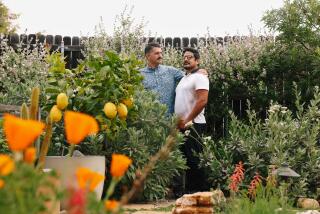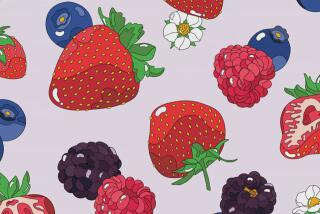Growing blackberries: Sweet fruit, minus the thorns
The thornless blackberries in Mary Steffens’ backyard in Echo Park are going on three years, and one of the plants is finally setting fruit -- big, purple-black globes of nearly seedless, sweet-tart juiciness.
Steffens got the plants from a friend at Ocean View Farms, the community garden in Mar Vista, but her initial planting site was too sunny. So two years ago she moved the plants to a spot that got late afternoon sun but was shaded during the hottest part of the day.
“This is basically a Northern Californian berry,” she said. “They don’t like heavy heat. The first year it was just getting established, but now it’s giving berries.”
The blackberry (Rubus fruticosus) in some places is considered an invasive weed, a blight plant that occupies vacant lots. Commercial production didn’t start in America until the 1870s. It got a jumpstart when horticulturist Luther Burbank developed a thornless variety around the turn of the century with vines “as smooth as a pussy willow.” He combined a nearly thornless East Coast wild dewberry plant (Rubus canadensis) with a highly prolific but thorny Himalaya variety from India that bore vines 100 feet long and could produce hundreds of pounds of sweet, spicy fruit.
Taking the prickle out of the bramble was a landmark achievement, and now hybrids number in the hundreds, many coming from the University of Arkansas, which uses some Burbank scions for breeding stock.
Local nurseries may stock popular favorites such as the thornless Triple Crown. Most varieties are best planted in winter or spring, and they fruit in late spring and summer. The harvest time is short, mid-May through June. But ask about late-season varieties. A relatively new one from the University of Arkansas named Prime-Jim flowers in midsummer and fruits in the fall.
To get a “true” Luther Burbank thornless blackberry, you’ll have to visit the Luther Burbank Home & Gardens in Santa Rosa. The landmark, where Burbank lived and worked for 50 years, has a small retail nursery and will root out Luther Burbank thornless blackberry cuttings for visitors with advance notice.
Garden coordinator Rachel Spaeth said Steffens made a good decision to move her lackluster blackberries into partial shade. Spaeth’s advice: ”Deep shade for most of the morning and then good filtered afternoon sun.”
Blackberries (technically not a berry but an aggregate fruit, like a pineapple) have become a global product, with much of the U.S. production coming from the Mexican states of Michoacan and Jalisco. Blackberries are easy to grow and tolerate poor soil but are susceptible to verticillium wilt; they should be kept away from any plots where tomatoes, potatoes or eggplants have grown.
At the end of the season, the flowering canes should be cut back severely because fruit appears on new growth.
ALSO:
Rocoto chile delivers some homegrown heat
The Global Garden, our series on plants from around the world as reflections of L.A.’s cultures and communities, appears here on Tuesdays. For an easy way to follow the L.A. scene, bookmark L.A. at Home and join us on our Facebook page for home design, our Facebook page for California gardening, Twitter and Pinterest.






